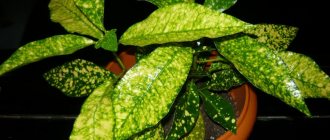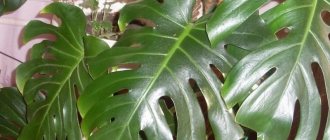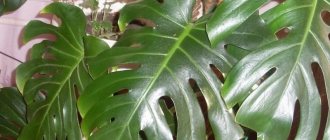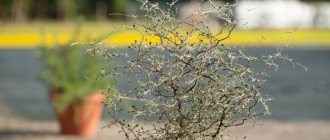Croton is narrow-leaved with the longest leaves. Indoor plant species and varieties
A single species, Codiaum variegatum, as well as its varieties and hybrid varieties, began to be grown as indoor plants.
But they represent such a wealth of shapes and colors that other types were simply not useful. Varieties of Codiaum variegatum:
- The narrow-leaved croton is equipped with long (about 20 cm) leaves, their width is no more than 1 cm. Yellow-golden strokes and specks are scattered across the green background.
- The appendage-like croton is variegated and green. Its leaves, wide at the base, narrow in the middle into a kind of petiole, and then expand again, forming a small leaf appendage at the end.
- Curly codiaum (crispum) has long, narrow, curled leaves. The greenery has stripes, spots, veins or a network of different shades of yellow. The brightest representative of the variety is Spiral with uniform turns of leaves.
- Lobed croton is distinguished by wide leaves divided into three parts. The central lobe is much longer and wider than the lateral ones. Yellow veins decorate the bright green of the leaf.
- Flat-leaved (platyphyllum) codiaum is a plant with large (up to 30 cm in length and 10 cm in width), oval leaves, their edges are slightly wavy.
- Oval-leaved (ovalifolium) with simple leaf blades in the shape of an elongated oval with a rounded end, rich yellow markings located along the veins.
- The tortoiseshell variety (tortile) is distinguished by leaves that are broad at the petiole and taper towards the tip. On an olive green background there are red and yellow stripes along the central vein and chaotic golden spots.
- Genuinum is a variety with solid oval leaves covered with a pattern of silver or gold color with a reddish tint. There are forms with small and ribbon foliage.
- Codiaeum variegatum pictum is the original form for most hybrid varieties. This is a shrub with a straight stem (up to 1 meter in height), which is covered with dense and hard leaves. They are painted with a pattern of bright yellow, red, pink spots on a green field.
Croton Flower: Cinderella at the Royal Ball
However, not all flower growers can say that they have seen croton bloom. Although the inflorescences of this plant cannot compete with the foliage in either size, shape, or brightness of shades, they are also worthy of attention. Loose racemose inflorescences are formed in the axils of the leaves and unite 1.5–2 dozen small whitish flowers. Croton flowers are divided into male and female specimens, opening simultaneously, but located on different inflorescences.
The first ones are easily recognized by the presence of small bent petals and fluffy stamens, thanks to which they look like small pompoms.
But the female croton flowers, as in the photo, are inconspicuous and unattractive, like Cinderella, who lost her shoe and the sparkling lights of the royal castle.
Croton codium angustifolia. Variegated codiaeum (Codiaeum variegatum) Variegatum
The ancestor of all cultural species of Codiaums. In nature, it grows either as a shrub up to 1.5 meters in height, or as a four-meter tree with smooth branches and leaves located only at the ends of the branches. At home it grows up to half a meter.
It has large, up to 25-30 cm leaves, arranged alternately. The leaves are leathery and dense. Has a wide variety of colors. It grows slowly. Through selection, various species with different leaf shapes have been bred from it. In this codiaum they are initially oval in shape, the leaf blade is even.
Croton variegated
Varieties of Codiaum motley:
- Genuinum - leaves with smooth edges, flat, oval or lancet-shaped, with pointed tips at the base and tips. On the upper side of the leaf, along the central vein, golden patterns are visible. There are species with a reddish tint to the initially growing leaves;
- Decorated (picturatum) - the leaves are narrower, closer to lanceolate, the color is approximately the same as the previous variety;
- Tortoiseshell (tortile) - the leaf plate is heart-shaped at the base, then elongated with a pointed tip, twisting slightly around its axis. The color is variegated: a red central vein and a golden stripe stand out against a green background. On both sides of the sheet there are irregular spots of the same color;
- Trilobate (trilobium) - the base of the leaf is deltoid. The leaf plate itself is divided into three parts. The color of the leaves is very diverse - from stripes of different colors along the veins, to different colored spots or a combination of both;
- Wrapped (volutum) - broadly lanceolate long leaves curled towards the base. Over time, the plant takes on the shape of a ball and looks very original;
- Narrow-leaved (angustifolium) - linear narrow leaves reach a length of 25 cm with a width of 0.5 to 1 cm. Veins and random spots located on the leaves can be colored yellow.
- Appendiculatum Celak. – Distinguished by the unusual shape of the leaves. The broad oval plate at the apex narrows to a vein and then expands again, forming, as it were, a second leaf.
What conditions need to be created at home?
There is a version that it is the non-standard coloring of codiaum leaves that causes its capriciousness. The lack of green color in the ground organs of the flower impedes the process of photosynthesis, which, as is known, provides the plant with the energy it needs. Therefore, in order for the croton to feel comfortable, it is so important to create the most favorable conditions for it, otherwise the flower may not be able to endure the struggle for survival.
Did you know? In 1950, a special croton nursery was opened in the American state of Florida, where you can see more than five hundred different varieties of this plant.
Selecting a location
The wrong choice of location is the first mistake of an inexperienced gardener, which can cost the codiaum its life. Croton's needs in this regard are very contradictory, so it can be quite difficult to satisfy them. In particular, the owner needs to take into account that this flower:
- loves warmth, but does not tolerate dry air, so it should not be placed near heating devices;
- photophilous, but gets burned in direct sunlight and often loses its leaves;
- It is absolutely not adapted to sudden changes in temperature, and can die from the slightest draft.
Important! The brightness and variegated colors of codiaum directly depend on the lighting, and not only its intensity, but also its duration plays a role here. Any variety of croton, when in the shade, has solid green leaves.
The best place for a codiaum is east or west windows. Away from light, you can place those varieties of plants that have green leaves without rainbow splashes.
Air temperature and humidity
Croton loves warmth, but the problem is that in city apartments, both in summer and during the heating season, the hot air is too dry, so the optimal conditions for the plant are considered to be temperature parameters between +20 and +22 ºC, and the permissible maximum is at +28 °C. In winter, it is better to maintain these indicators at +18…+19 °C. It is also important that fluctuations between day and night temperatures do not exceed two to three degrees.
Humidity is one of the most difficult conditions in caring for codiaum. The flower suffers so much from dry air that regular spraying cannot solve the problem. Experts recommend using additional humidifiers, for example, placing containers with moss, sand or expanded clay around the pot, and constantly adding water to them. You can place the plant in a special glass container for growing - a florarium, where it is much easier to create a suitable microclimate for it.
In addition to air humidification, an integral part of codiaum care is the regular removal of dust from the leaf blades, otherwise the already complicated process of photosynthesis may slow down even more. Periodically, the plant can be bathed in the shower, protecting the surface of the earth from excess water.
Croton pictum angustifolia. Botanical description of the plant
Croton (Latin name Codiaeum) is a perennial evergreen plant of the Euphorbiaceae family. In nature, it is found in tropical and subtropical forests of Australia, Oceania (Polynesia), India, as well as some islands of Southeast Asia (Malaysia, Philippines, etc.). Due to the amazing colors of the leaves, the flower is sometimes popularly called “Joseph’s Cloak.”
Did you know? Codiaum is the original name of the plant, probably coined by its discoverer, the Dutchman Georg Rumphius, who studied orchids on the island of Ambon in Indonesia in 1654 and saw the original shrub there. Local residents called the perennial with the beautiful word “kodibo”, although today “codiaum” is rather associated with the Greek “codeia”, which means “head”.
Despite the fact that the plant came to Europe in the second half of the 17th century, the real fashion for it began only three hundred years later. Together with Dieffenbachia and Dracaena, croton initially began to be grown by flower growers from the Netherlands, and from there it began to conquer the world.
When describing the botanical features of codiaum, it is necessary to highlight the following main characteristics of the plant:
| Maximum dimensions | 50–150 cm (in the wild - up to 300 cm) |
| Root system | Powerful, fast growing |
| Stems | Dense, erect, with a large number of lateral processes |
| Leaves | Petiolate. The structure is dense and leathery, with a beautiful gloss. The sizes are large (up to 30 cm in length). The shape can be different (lanceolate, three-fingered, oval, lobed, carved, spiral, often flat, but sometimes with wavy edges). A distinctive feature is a bright and bizarre color: against the main background of any shades of green, there may be stains, veins, stripes, inclusions and other fragments of yellow, white, purple, pink and other contrasting or nuanced colors |
| Inflorescence | Racemose (panicle) |
| Flowers | Small, undecorative, white, yellow or beige with long protruding anthers |
| Fruit | Box with large seeds inside |
Important! Like other Euphorbias, codiaum is poisonous. It is not advisable to keep such a flower for people who have pets (primarily cats). Also, croton juice can cause serious irritation on the skin, so pruning and replanting the plant should be done with protective gloves.
An interesting botanical feature of codiaum is the ability to change the color and shape of leaves depending on environmental conditions. It is on this amazing property that active breeding work aimed at developing new varieties of decorative flowers is based.
Croton angustifolia propagation by cuttings. Croton propagation methods
Nowadays, florist shops delight amateur gardeners with an abundance of indoor plants. There are palm trees, cacti, exotics with bright flowers and spicy aroma, and even amazing and dangerous insectivorous plants. Among the wide selection of indoor plants, croton occupies not the last place. The article will discuss how you can propagate this interesting flower at home.
Description
Croton is a perennial, its colors similar to the riot of colors in the autumn forest. This comparison is not accidental - on the leaves of croton you can see green, yellow, and red. Croton blooms rarely; the flowers are small, pale yellow, collected in clusters, with a light honey aroma.
Croton belongs to the Euphorbiaceae family. It grows naturally in southeast Asia and can grow up to 3 meters in height. In captivity, croton grows to a maximum of one and a half meters.
It should be said that croton is a capricious plant, and caring for it is not so easy. However, it is beautiful and can decorate any interior.
How to propagate?
There are 4 ways to propagate croton. Let's list them, and then consider each in more detail:
- cuttings;
- seeds;
- leaves;
- layering.
Let's look at each method step by step.
Cuttings
Probably the most popular way. To implement it, it is necessary to select mature cuttings from 8 to 15 centimeters long, cutting them from the “head” or side trunk of the croton. It is best to carry out the procedure in the spring, when daylight hours will increase and the sprouts will be able to receive enough light for full growth and development.
Although, if it is possible to use phytolamps, you can propagate croton all year round.
Let's look at the step-by-step procedure for propagation from cuttings.
- Prepare the shoot, cut off all its lower leaves, wash off the milky juice released at the cut site, thoroughly blot the “wound” with a paper napkin and sprinkle it with crushed activated carbon. Let the cutting dry a little, at least 2-3 hours.
- Tie all the leaves remaining on the shoot into a tube, and if there are large leaves left on top, cut them in half so that the “baby” croton can retain moisture inside.
- Prepare the container in which you will grow the “baby”. Pour a drainage layer there (for example, expanded clay), then fill it with a sand-peat mixture. Plant the cutting there, cover the top with cellophane with small holes made (for “breathing”) and place it in a warm place where diffused light reaches.
- After a month, you will see that the cutting has begun to grow. This propagation method is suitable for all varieties of crotons. The “parent” flower, after cuttings, as a rule, soon produces new shoots.
There is another method of growing cuttings - using water. Let's consider it.
- We take settled water with a temperature no lower than room temperature (optimally 26 degrees above zero) and place the “baby” in it.
- After the white roots appear and reach a length of 3 centimeters, we transplant the sprout into a container with the mixture mentioned above. Cover with cellophane.
- Be sure to monitor the ambient temperature. It should not fall below +23 degrees and rise above +28. But we also adjust the lighting - it should be diffused light, soft, without direct burning rays. Provide the croton with long daylight hours - at least 12 hours. If necessary, “extend” it with the help of a phytolamp.
- After 30-35 days the sprout will take root. Transplant it into a small pot with a drainage layer and nutritious soil mixture. After the croton begins to grow and its roots fill the container, transplant the plant into a pot larger in diameter - about 15 centimeters.
Seeds
Another way to propagate croton is using seed material. For planting, only freshly harvested seeds are used, as they very quickly lose their viability. Seed propagation is carried out in winter (late January - early February).
Let's look at this process step by step.
- First of all, immerse the seeds in an aqueous solution of phytohormones for about 2-3 hours. Some amateur gardeners simply soak the seeds in very warm water (60 degrees Celsius), keep them there for 30 minutes, and then leave them to swell for 24 hours.
- We sow the seeds in a prepared seedling box or any other similar container. Sowing depth is 10 millimeters.
- We put the box in a warm place (the optimal temperature is 21-23 degrees above zero) and cover it with cellophane or glass. We make sure that the top layer of soil is always moist.
- After 30 days, the seed material sprouts. When each of them produces 3 leaves, they need to be planted in different pots of small diameter - 5-7 cm.
- They care for small crotons in the same way as adults: water, spray, ventilate the room in which they are located, provide diffused lighting and warmth.
Diseases
The plant rarely gets sick because it is poisonous. But errors in care can lead to illnesses.
Sometimes bushes suffer from anthracosis. The disease appears with frequent watering with cold water. A sign of anthracosis are ashy red and gray spots on the foliage. The fungus is very dangerous for the crop. It penetrates the plant tissue and infects it. Diseased bushes must be isolated and treated with an antifungal agent. All plants that have been in contact with croton must be treated with biological products.
Root rot is no less dangerous. It may appear due to low acidity of the soil. A sign of the disease is paleness and falling leaves. Subsequently, the stems and roots soften. To combat rot, broad-spectrum antifungal substances are used.
Spider mites can settle on weakened plants. In this case, a thin cobweb appears on the plant. The reason for the appearance of parasites is dry air and lack of watering.
When a light fluffy coating appears on the foliage, we can say that it is a mealybug. Scale insects can also settle on croton. In this case, spots appear on the foliage. When pests appear, the pot with the plant must be isolated and treated with a soap solution. Afterwards, the foliage must be wiped with vegetable oil. If the bush is heavily damaged by pests, you can use Actellik or insecticides for treatment.
Croton angustifolia care at home. Secrets of caring for codiaum at home
Caring for decorative perennials is not too difficult, especially for the most unpretentious varieties and species. The main conditions for proper cultivation are the use of high-quality nutrient soil, comfortable temperature conditions, optimal humidity levels and timely pruning of the above-ground part.
Requirements for soil and planting pot
Codiaeums grow and develop well in the presence of loose and well-fertilized soil. Purchased soil for flowering ornamental and deciduous plants is optimally suited for this purpose. When preparing it yourself, you should mix an equal amount of turf, leaf soil, peat chips and medium-grained sand.
The soil mixture is pre-frozen or calcined. Drainage based on expanded clay or clean pebbles must be poured into the bottom of the flower pot. The pot for growing a young plant should be of medium size. The flower pot should not be deep. An adult plant is grown in larger pots and flowerpots.
Optimal growing conditions
The heat-loving crop grows and develops at a temperature of 21-25°C. It is necessary to protect the plant from drafts and cold winds. In summer, the plant should be protected from direct sunlight to avoid burns of the foliage. East or west windows are best suited for placing a flower pot. In winter, you can place an indoor flower on a sunny southern windowsill.
Insufficient lighting negatively affects the decorative appearance of the plant - the foliage loses its bright color and becomes uniformly green. Croton loves bright, but fairly diffuse lighting and high humidity. The foliage should be wiped on both sides with a damp cloth. Once a week in the morning, spraying is carried out with warm and settled water with the addition of growth stimulants “Zircon” and “Epin-extra” or “Immunophytophyte”.
Briefly about cultivation
- Flowering: the plant is grown as an ornamental foliage plant.
- Lighting: In poor lighting, the pattern on the leaves disappears, so variegated species need bright, diffused light.
- Temperature: in summer – about 22 ºC, in winter – not lower than 18 ºC.
- Watering: The plant is watered all year round as soon as the top layer of the substrate dries.
- Air humidity: Croton requires daily spraying and maintenance on a tray with damp pebbles.
- Feeding: alternately with mineral and organic fertilizers in low concentration: in spring, summer and autumn - weekly, in winter - twice a month.
- Pruning: Croton needs to be pinched: the first time - on the top bud, when the plant reaches 15 cm, then every 20 cm.
- Transplantation: in spring, young croton - annually, adult plants - once every 2-3 years.
- Substrate: from equal parts of peat, humus, sand, leaf and turf soil.
- Rest period: not expressed.
- Reproduction: by cuttings.
- Pests: thrips, mealybugs, scale insects and spider mites.
- Diseases: sometimes problems arise due to the sensitivity of croton to violation of maintenance conditions and improper care.
- Properties: croton milky juice is poisonous!
Read more about growing croton below.
Codium croton angustifolia. Croton - species with photos and names
Codium variegated is grown at home. Common varieties:
- Codium Sunny Star. Leaves with a tapered end. Young foliage is light green with bright yellow streaks.
Croton Sunny Star
- "Aucuboleous". Foliage is unevenly colored. There are yellow and green tones. This croton is narrow-leaved.
Codiaum aucubifolia
- Codium Vilma - multi-colored asymmetrical yellow-green leaves.
Croton Wilma
- Petra. A flower with yellow spots on the leaves. Large bush with lateral leathery leaves. On the shoots they are located alternately.
Croton Petra
- Mammy. Flower with red veins on the leaves, narrow-leaved. If properly cared for, there are bright yellow, green, and pink tones. The edges of the leaves are slightly curved.
Mammy
- Codiaeum Disraeli. Lobed leaves of a brown hue. The outer side of the leaf blade has bright yellow spots and veins.
Croton Disraeli
- Codeium Excellent. The foliage looks like oak. There are clear green and yellow blotches and stripes on the surface of the leaves. The reverse side of the foliage is pinkish.
Codeium Excellent
- Zanzibar. Dense narrowed leaves of a bright green hue. There are orange, yellowish, burgundy stripes.
Zanzibar
- Mrs Eyeston. A compact tree or spreading bush with large green leaves grows. On the surface of the foliage there are pinkish, burgundy spots, and yellowish stains.
Mrs Eyeston
- Black Prince . Dark green leaves with red, orange spots and stripes.
Black Prince
- Nervia. Multi-colored greens - leaves of a yellow, pinkish hue. The edges are wavy. There is a central vein on the surface.
Nervia
- Croton Tamara. The tone of the oval leaves may be green. The edges are light green or white.
Croton Tamara
- Codium Gold Sun. Large variegated foliage. The main color is green, there are yellow veins. Height more than 30 cm.
Codeium Gold Sun
Codiaum Variegatum Mix is often sold. This is not one variety, but several. Codium Mix can be of different colors. It depends on the age of the crop and its growing conditions. Therefore, compositions with the same varieties often look different.
Croton angustifolia propagation. How to propagate croton by cuttings and leaves at home
You can’t even imagine how exciting the process of croton propagation can be! I had no idea about this before. Until one day I had a cutting of this beautiful plant in my hands.
It's all because of my curiosity. But the process fascinated me so much that today, thanks to my efforts, crotons grow in all my friends. And every single one of them is happy about such a gift.
This unusually bright plant with large, catchy leaves is liked by many gardeners for its ease of cultivation and propagation. After all, in the end, without putting in a lot of effort, you can get a luxurious plant that will delight you with many beautiful shades of foliage.
The plant is very decorative; in natural conditions it reaches a height of three meters. At home, this deciduous plant can grow up to one and a half meters in height. As an indoor crop, croton is grown for its beautiful variegated leaves that have a wide variety of shapes.
Moreover, it is known that the plant has a beneficial effect on the nervous system and can calm and improve mood. Its leaves disinfect indoor air, which is especially important in dusty and polluted urban environments.
Description
In nature, croton is found in the tropics of India and Southeast Asia. The second name for croton is codiaum, which comes from the Euphorbiaceae family. Translated from Greek, the word codeia means head. A little unclear, but nonetheless a fact.
It is distinguished by its oval, slightly elongated shape of leathery, dense leaves. Leaves of various shapes have a wide variety of shades.
Croton is also popularly called indoor oak; it can have not only variegated leaves, but also light green, yellow - very different hybrid varieties have been bred by breeders.
A characteristic feature of croton leaves is the ability to change the color of the foliage, but not at all due to the change of seasons, but everything depends on age-related changes. Codiaum blooms with completely inconspicuous, small flowers; it is better to remove them due to the lack of decorativeness, but croton did not waste energy on their development.
The developed varieties of croton differ in leaf shape:
- appendage - a leaf of green or variegated color, has a bridge, consists of two parts.
- lobed - the leaves have a three-lobed shape, the middle part is somewhat elongated, up to 20 centimeters, has stripes and spots.
- flat-leaved - large oval leaves have wavy edges.
Kinds
Codiaum variety Mammi
It has narrow and small leaf blades, their edges are smooth and wavy. The leaves curve along the central vein. The color of croton can be completely different; even on one specimen you can find leaves of both red and green with pink and yellow spots.
Codeium Excellent
This croton has leaf blades shaped like large lobes. The color of the leaves is green with yellow veins. The inner side of the leaf is red and has brownish veins.
Croton Mrs. Eyeston
Croton Mrs. Iceton has leaf blades that are quite wide, but short. On younger plants the foliage is a soft cream color.
As they get older, the leaves change color to pink or bright red with lots of splashes of yellow. In some specimens you can see leaves of a very dark, almost black color.
Codium Mix
This type of croton is distinguished by the presence of a mass of subspecies. It has pointed, long leaf blades that grow up to 20 centimeters. There are even varieties with 30 centimeter leaf blades.
Croton Sunny Star
Its leaf blades are green, and the tops themselves are yellow. The leaves have a slightly pointed, lanceolate shape. Young leaves are bright green with yellow veins.
Codiaum aucubifolia
It is very popular among gardeners for indoor growing. The leaf blades are unevenly colored, with yellow-green tints. The leaves are medium sized, rather narrow.
Croton: description, reproduction and care,
Propagation of codiaum using cuttings
With this method of propagation, a lot will depend on the chosen cutting itself; you need to decide which part of the plant to take the cuttings from and what time to choose for this.
All months are suitable for propagation, with the exception of January-February, since this is the resting time for the plant. Rooting of cuttings during this period will be weak, or may not occur at all.
The best time to root cuttings, of course, is spring.
Diseases and pests
Popular types and varieties of zucchini
Croton is pleasantly disease resistant. What appears to be a disease at first glance is usually the result of neglect.
- Leaf falling: the plant is located in too dark a place.
- Dropping leaves from below: the plant is in a draft.
- Color Fading: Light intensity is well below 75 percent, so repositioning is recommended.
- Drying leaves or brown tips: Humidity too low. Requires daily spraying with settled water.
If the colorful ornamental leaves gradually turn green, this is neither a disease nor a care error. Colorful hybrids tend to adopt the green foliage of their wild species. You can stop this process by cutting off the green leaves one by one. Please make sure in advance that the landscaping is not due to the location being too dark.
Pests
Poisonous milky sap does not protect croton from pests. Curled leaves indicate an infestation of sucking insects such as aphids and mealybugs. Affected plants must be immediately isolated and treated.
In the early stages of infection, spray the bush with a powerful stream of water. Aphids are effectively treated with a mixture of 1 liter of water and 1 tablespoon of mild soap. Stubborn mealybugs should be removed using a rag soaked in an alcohol solution.
If necessary, use insecticide chemicals to control pests, following the instructions for use.











